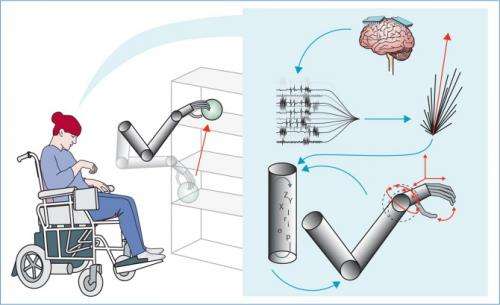Mind-controlled hand offers hope for the paralysed

Pentagon-backed scientists on Monday announced they had created a robot hand that was the most advanced brain-controlled prosthetic limb ever made.
The mind-powered prosthesis is a breakthrough, the team of neurologists and bio-engineers reported in The Lancet.
With further development "individuals with long-term paralysis could recover the natural and intuitive command signals for hand placement, orientation and reaching, allowing them to perform activities of daily living," they said.
Researchers have long been interested in the brain-machine interface, whereby implants pick up electrical signals in parts of the brain associated with movement.
These signals are then transcribed into computer code, which orders the artificial limb to move.
The new work vastly improves the code, or algorithm, by which the first signal is transcribed into the second, the investigators said.
"One of the biggest challenges has always been how to translate brain signals that indicate limb movement into computer signals that can reliably and accurately control a robotic prosthesis," said Andrew Schwartz, a professor of neurobiology at the university.
"Most mind-controlled prosthetics have achieved this by an algorithm which involves working through a complex 'library' of computer-brain connections," he said.
"However, we've taken a completely different approach here, by using a model-based computer algorithm which closely mimics the way that an unimpaired brain controls limb movement. The result is a prosthetic hand which can be moved far more accurately and naturalistically than previous efforts."
The team, based at the University of Pittsburgh in Pennsylvania, implanted two microelectrode arrays into the left motor cortex of a 52-year-old woman.
She had been left paralysed from the neck down, unable to move her arms and legs due to a condition called spinocerebellar degeneration.
Two weeks after the operation, the prosthesis was connected and the woman embarked on 14 weeks of training—but on only the second day, she was able to move the limb through mind power.
The training aimed at achieving skills in nine tasks, such as gripping and moving small objects, stacking cones and bumping a ball so that it rolled outside a loose coil of wire.
At the end, the volunteer completed the tasks with a success rate of up to 91.6%, and more than 30 seconds faster than at the start of the trial.
The researchers said they were sure this is a success as they used an exhaustive benchmark test designed to identify genuine changes and root out flukes or anecdotal evidence.
The next steps are likely to see a robot limb incorporate sensors to tell the patient whether a surface is hot or cold or rough or smooth, and to use wifi, rather than a wire, to connect the patient's skull and the prosthesis.
In October 2011, a team at Duke University in North Carolina reported that they had implanted brain electrodes in monkeys that enabled the animals to sense the texture of a virtual object.
One of the funders of the latest study is the Defence Advanced Research Projects Agency (DARPA), a branch of the US Department of Defence that looks into futuristic technology with a potential military use, including by wounded veterans.
More information: Paper: www.sciencedirect.com/science/ … ii/S0140673612621643
(c) 2012 AFP















